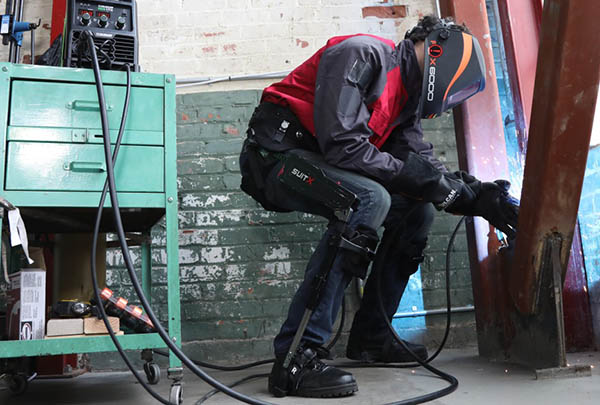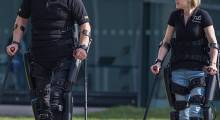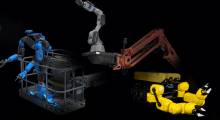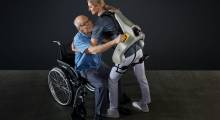The number of assistive or therapeutic exoskeletons is still relatively small, but vendor consolidation could give it a boost. Ottobock SE & Co., which makes prosthetics, orthotics, and exoskeletons, today announced that it has acquired suitX, which develops occupational and medical exoskeletons. The companies said their combined expertise and products will “take the exoskeleton market to a new level and ... foster the worldwide adoption of exoskeletons.”
Wearable assistive devices such as exoskletons can augment or restore human performance, said Ottobock, which was founded in 2019. They can support specific parts of the body, such as the shoulders, arms, or legs, as well as provide assistance for applications in automotive manufacturing, maintenance work, or logistics.
The market for industrial exoskeletons will grow to several hundred million dollars by 2025, according to the Duderstadt, Germany-based company. Work-related injuries, especially musculoskeletal disorders (MSD), create significant cost for companies, it noted. They are the No. 1 cause for work absences, resulting in an estimated annual cost of at least $45 billion in the U.S. alone.
Exoskeletons for able-bodied users address MSD issues by reducing load for workers, reducing the number of sick days by 25%, Ottobock said. It claimed that investments in exoskeletons can achieve a return on investment in two years.
The use of exoskeletons in commercial work and logistics can help increase productivity, make manual labor more attractive and safe, and mitigate the increasing shortage of skilled workers in these industries, said Ottobock. In addition, the expected reduction in MSD can not only benefit worker health, but it can also ease the cost burden on employers and public health systems, it said.
Ottobock, suitX offer complementary products
Ottobock and suitX said their portfolios are are complementary, and together they will offer exoskeletons that relieve strain on the body during overhead work and jobs involving lifting. Ottobock’s Paexo product range includes systems that support the wrist, thumb, and neck. suitX develops and manufactures occupational, healthcare, and recreational exoskeleton systems.
“Our exoskeletons offer a huge relief of physical burdens for the workforces in many industrial and logistic workplaces,” said Dr. Soenke Roessing, head of Ottobock Bionic Exoskeletons. “Shortage of skilled labor, an aging workforce, increasing importance of employee safety and injury prevention, as well as a growing awareness of injury costs will contribute to the dynamic growth of the market.”
“We expect that recent technological advancements in weight, ergonomic fit, and functionalities, paired with increasing affordability, will fuel adoption rates in the industry,” he said. “We believe that major industrial and retail companies will lead this development and pave the way for their industries.”
The occupational exoskeletons offered by suitX include backX, legX, and shoulderX modules to reduce the risk of injuries among workers. Each module can be worn individually or in combinations suitable for various industrial work settings.
In the healthcare arena, Phoenix, a lightweight and FDA-approved exoskeleton, allows individuals with spinal cord injuries to be upright and mobile. suitX said it is developing a new line of exoskeleton products to support their wearers during recreational activities.
Executives hail exoskeleton merger
Emeryville, Calif.-based suitX spun out of the Robotics and Human Engineering Lab at the University of California, Berkeley, in 2012. Dr. Homayoon Kazerooni, a professor of mechanical engineering at UC Berkeley and founder and former CEO of suitX, will remain with the company as chief scientist.
“I am thrilled about our new chapter of research and innovation with Ottobock,” said Kazerooni. “What truly resonates with me is that Ottobock stands for quality of life. Together with Ottobock, we will provide lasting changes to communities worldwide with our state-of-the-art innovation in exoskeleton technologies.”
“I have been lucky to teach and conduct research in Berkeley, a leading public university in the U.S.,” he added. “Our research activities on robotic exoskeletons have received both public and private funding. Giving back to the world with our research and innovation is not only our duty, but also an honor. I feel fortunate that I am now put in a position to deliver our life-enhancing medical and industrial exoskeleton products globally.”
“This step is a success not only for suitX but also for the University of California, Berkeley, where entrepreneurial endeavors are fostered to their greatest extent for the good of humans worldwide,” Kazerooni said. “I'm looking forward to bringing our technologies to communities internationally with Ottobock for better quality of life. That's what it is all about, and it makes me very happy.”
suitX will become part of Ottobock Bionic Exoskeletons —formerly Ottobock Industrials— the company's division for the development of occupational exoskeletons. The management of Ottobock´s global Bionic Exoskeletons business under the brand name Paexo will continue to be handled from Germany.
“Together with suitX, Ottobock´s exoskeletons business Paexo will become a world-leading provider of exoskeletons in production, logistics, servicing, and the trade sector,” stated Philipp Schulte-Noelle, CEO of Ottobock. “We will jointly create significant socio-economic benefits by improving occupational health for employees while reducing sickness absence and treatment costs for companies and healthcare systems.”
“This transaction increases our footprint and network in North America and comes at the perfect time, as we expect the market for occupational exoskeleton solutions to grow dynamically in the coming years,” he said.
Article topics
Email Sign Up
















